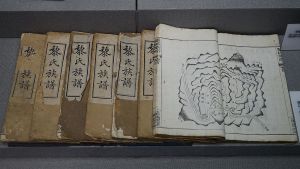Genealogical Preservations and the Moveable Type: Difference between revisions
| Line 9: | Line 9: | ||
== Diffusion of the Moveable Type == | == Diffusion of the Moveable Type == | ||
The speed of diffusion and the popularity of the Moveable Type differed vastly between European and Asian countries. This difference is primarily attributed to the “limitless repertory of Chinese characters,” as there are more than 8000 common characters in Chinese typography. <ref name = "[3]"> He, Zhou. “Diffusion of Movable Type in China and Europe: Why Were There Two Fates?” Gazette (Leiden, Netherlands), vol. 53, no. 3, 1994, pp. 153–173., doi:10.1177/001654929405300301. </ref> In his book “Books and Printing in Sung China”, Ming-sun Poon discusses that Chinese printing presses need a font of 100,000 sorts while Western types, with upper and lower case letters, numerals, signs, and punctuations, require no more than 150 sorts. <ref> Poon, Ming-sun. Books and Printing in Sung China. Verlag Nicht Ermittelbar, 1979. </ref> Therefore, the widespread usage of the Moveable Type occurred at much slower rates, and were afforded only by the wealthiest in society. | |||
== Printing Genealogies == | == Printing Genealogies == | ||
Latest revision as of 05:17, 3 December 2020
The inception of Chinese printing dates back to the Song Dynasty, during which arts, literature, and technology flourished. [1] Even though printing had previously existed in China for hundreds of years, the eleventh century brought forth printing of materials other than religious texts and divinations, and launched the Moveable Type into widespread use.

Origin
During the Song dynasty (A.D. 960-1127), movable type was used exclusively in the Northern Zhejiang Province. This limited usage is corroborated by the fact that ceramics containing prints were also produced in the same area, and local printing activities existed to support the ceramic production. [1] The use of “double plates of metal” (二板铁), as documented in the Collected Works of Mr. Binglü [2], refers to the two metal trays within which the types are placed to speed up the process of alternating the type positioning and subsequent printing.
Diffusion of the Moveable Type
The speed of diffusion and the popularity of the Moveable Type differed vastly between European and Asian countries. This difference is primarily attributed to the “limitless repertory of Chinese characters,” as there are more than 8000 common characters in Chinese typography. [3] In his book “Books and Printing in Sung China”, Ming-sun Poon discusses that Chinese printing presses need a font of 100,000 sorts while Western types, with upper and lower case letters, numerals, signs, and punctuations, require no more than 150 sorts. [4] Therefore, the widespread usage of the Moveable Type occurred at much slower rates, and were afforded only by the wealthiest in society.
Printing Genealogies
Due to the difficulty of printing and the vastness of character collections in order to fully execute the printing process, printing was allocated for the wealthy, and usually was carried out by non-professionals. When Zhai Jinsheng, a scholar in the Qing Dynasty (1640-1911), produced 100,000 types in five different fonts, he printed four books — “a collection of Zhai’s poems, a collection of a friend’s poems, a work by one of his cousins, and a genealogy of Zhai family”. [3] The importance of documenting a family’s lineage is demonstrated by the prioritization of genealogies as one of the first printed texts by ancient Chinese scholars.
Modern Day Genealogical Preservation Efforts
Despite the obsolescence of the Moveable Type due to modern breakthroughs in printing and digitization, wooden movable-type printing is still being maintained in Rui’an County, Zhejiang Province. [5] For the sake of compiling clan genealogies, men in the County draw and engrave Chinese characters on wooden blocks and arrange the printing of texts, while women cut and bind the paper until an entire genealogy is complete. Due to the expensive nature of such printing techniques and its obsolescence due to modern technological innovations, the traditional practice of printing genealogies with moveable types may soon disappear. Therefore, national and international effort is required to preserve this cultural and historical heritage.
Fortunately, modern-day digitization and preservation efforts have been pushed forth by the National Library of China. During the Chinese Japanese war (1937-1945), large amounts of genealogies were damaged, which captured the attention of the NLC immensely. To preserve these documents against the war, 20 years of collecting ensued. By the end of 1950, 348 titles of genealogies were collected. [6] By the end of December, 2012, over 50,000 volumes of genealogies now reside in the NLC, with recent efforts to digitize these rare collections. Through this database, one can explore the already digitized genealogical collections in China. Although this is an ongoing effort, over 5300 sheets are now accessible to all.
Bibliography
- ↑ 1.0 1.1 Bussotti, Michela, and Han Qi. “Typography for a Modern World?: The Ways of Chinese Movable Types.” East Asian Science, Technology, and Medicine, no. 40, 2014, pp. 9–44. JSTOR, www.jstor.org/stable/eastasiascietech.40.9. Accessed 27 Nov. 2020.
- ↑ “栟榈集 (四库全书本)/全览.” 栟榈集 (四库全书本)/全览 - 维基文库,自由的图书馆, zh.wikisource.org/zh-hans/%E6%A0%9F%E6%AB%9A%E9%9B%86_%28%E5%9B%9B%E5%BA%AB%E5%85%A8%E6%9B%B8%E6%9C%AC%29/%E5%85%A8%E8%A6%BD.
- ↑ 3.0 3.1 He, Zhou. “Diffusion of Movable Type in China and Europe: Why Were There Two Fates?” Gazette (Leiden, Netherlands), vol. 53, no. 3, 1994, pp. 153–173., doi:10.1177/001654929405300301.
- ↑ Poon, Ming-sun. Books and Printing in Sung China. Verlag Nicht Ermittelbar, 1979.
- ↑ “Wooden Movable-Type Printing of China.” | Silk Roads Programme, en.unesco.org/silkroad/silk-road-themes/intangible-cultural-heritage/wooden-movable-type-printing-china.
- ↑ Xie, Dongrong, et al. “ The Collection and Digitization of the Genealogies in the National Library of China.” The IFLA Library, 24 June 2013, library.ifla.org/185/1/220-xie-en.pdf.